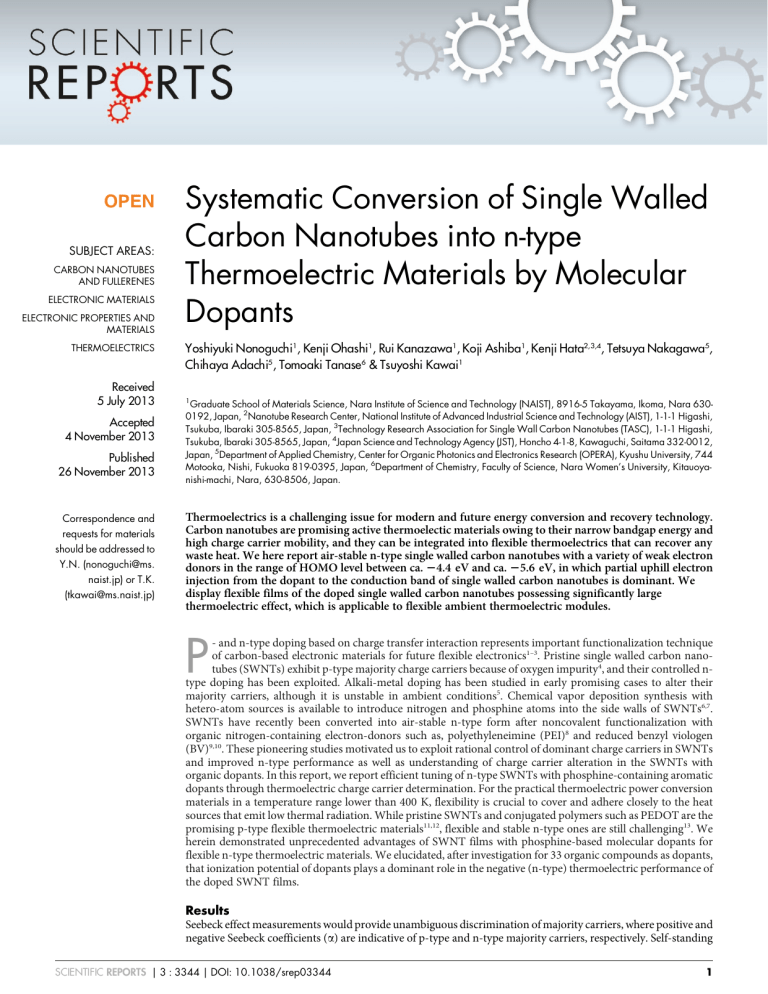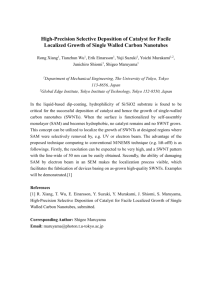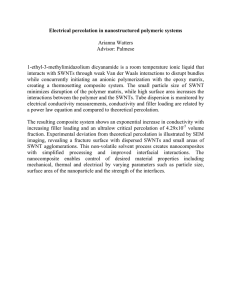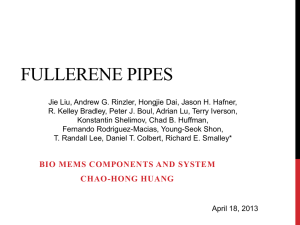Nonoguchi 2013 Systematic Conversion of Single Walled Carbon Nanotubes into n-type Thermoelectric Materials by Molecular Dopants
advertisement

OPEN SUBJECT AREAS: CARBON NANOTUBES AND FULLERENES ELECTRONIC MATERIALS ELECTRONIC PROPERTIES AND MATERIALS THERMOELECTRICS Received 5 July 2013 Accepted 4 November 2013 Published 26 November 2013 Correspondence and requests for materials should be addressed to Y.N. (nonoguchi@ms. naist.jp) or T.K. (tkawai@ms.naist.jp) Systematic Conversion of Single Walled Carbon Nanotubes into n-type Thermoelectric Materials by Molecular Dopants Yoshiyuki Nonoguchi1, Kenji Ohashi1, Rui Kanazawa1, Koji Ashiba1, Kenji Hata2,3,4, Tetsuya Nakagawa5, Chihaya Adachi5, Tomoaki Tanase6 & Tsuyoshi Kawai1 1 Graduate School of Materials Science, Nara Institute of Science and Technology (NAIST), 8916-5 Takayama, Ikoma, Nara 6300192, Japan, 2Nanotube Research Center, National Institute of Advanced Industrial Science and Technology (AIST), 1-1-1 Higashi, Tsukuba, Ibaraki 305-8565, Japan, 3Technology Research Association for Single Wall Carbon Nanotubes (TASC), 1-1-1 Higashi, Tsukuba, Ibaraki 305-8565, Japan, 4Japan Science and Technology Agency (JST), Honcho 4-1-8, Kawaguchi, Saitama 332-0012, Japan, 5Department of Applied Chemistry, Center for Organic Photonics and Electronics Research (OPERA), Kyushu University, 744 Motooka, Nishi, Fukuoka 819-0395, Japan, 6Department of Chemistry, Faculty of Science, Nara Women’s University, Kitauoyanishi-machi, Nara, 630-8506, Japan. Thermoelectrics is a challenging issue for modern and future energy conversion and recovery technology. Carbon nanotubes are promising active thermoelectic materials owing to their narrow bandgap energy and high charge carrier mobility, and they can be integrated into flexible thermoelectrics that can recover any waste heat. We here report air-stable n-type single walled carbon nanotubes with a variety of weak electron donors in the range of HOMO level between ca. 24.4 eV and ca. 25.6 eV, in which partial uphill electron injection from the dopant to the conduction band of single walled carbon nanotubes is dominant. We display flexible films of the doped single walled carbon nanotubes possessing significantly large thermoelectric effect, which is applicable to flexible ambient thermoelectric modules. P - and n-type doping based on charge transfer interaction represents important functionalization technique of carbon-based electronic materials for future flexible electronics1–3. Pristine single walled carbon nanotubes (SWNTs) exhibit p-type majority charge carriers because of oxygen impurity4, and their controlled ntype doping has been exploited. Alkali-metal doping has been studied in early promising cases to alter their majority carriers, although it is unstable in ambient conditions5. Chemical vapor deposition synthesis with hetero-atom sources is available to introduce nitrogen and phosphine atoms into the side walls of SWNTs6,7. SWNTs have recently been converted into air-stable n-type form after noncovalent functionalization with organic nitrogen-containing electron-donors such as, polyethyleneimine (PEI)8 and reduced benzyl viologen (BV)9,10. These pioneering studies motivated us to exploit rational control of dominant charge carriers in SWNTs and improved n-type performance as well as understanding of charge carrier alteration in the SWNTs with organic dopants. In this report, we report efficient tuning of n-type SWNTs with phosphine-containing aromatic dopants through thermoelectric charge carrier determination. For the practical thermoelectric power conversion materials in a temperature range lower than 400 K, flexibility is crucial to cover and adhere closely to the heat sources that emit low thermal radiation. While pristine SWNTs and conjugated polymers such as PEDOT are the promising p-type flexible thermoelectric materials11,12, flexible and stable n-type ones are still challenging13. We herein demonstrated unprecedented advantages of SWNT films with phosphine-based molecular dopants for flexible n-type thermoelectric materials. We elucidated, after investigation for 33 organic compounds as dopants, that ionization potential of dopants plays a dominant role in the negative (n-type) thermoelectric performance of the doped SWNT films. Results Seebeck effect measurements would provide unambiguous discrimination of majority carriers, where positive and negative Seebeck coefficients (a) are indicative of p-type and n-type majority carriers, respectively. Self-standing SCIENTIFIC REPORTS | 3 : 3344 | DOI: 10.1038/srep03344 1 www.nature.com/scientificreports flexible films made from long SWNTs14,15 were used for the measurements of thermoelectric properties and conductivity (Figure S1). A Seebeck coefficient of pristine SWNT films (149 mV/K) was drastically converted into negative values after treating SWNTs in suspended solutions with a wide range of electron donors (Figure 1a). All the dopants modulated the Seebeck coefficients ranging from 190 mV/K to 280 mV/K. Among them, eighteen dopants listed in Figure 2 successfully switched the majority carriers of SWNT materials from p- to n-type. This methodology is not limited to previously-known dopants such as PEI, but a series of electron donors can be effective for altering p-type SWNTs into n-type materials. Interestingly, we found that most phosphine derivatives promoted SWNTs into n-type form, as well as several amine-, and imine-containing molecules (PEI, PVP, Tetronic1107, Id, and PVPy). SWNT films combined with bidentate phosphine ligands, 1,3-bis(diphenylphosphino)propane (dppp), showed enhanced conductivity (s) up to 100 S/cm with a large negative Seebeck coefficient (a , 252 mV/ K), while undoped SWNT films showed s , 36 S/cm and a , 149 mV/K, respectively. The Seebeck coefficient of triphenylphosphine (tpp)-doped SWNT films (272 mV/K) was roughly twice as large as that of a PEI-doped film (a , 234 mV/K). These characteristics are advantageous for constructing thermoelectric devices, indicating that phosphine dopants therefore have potential for constructing a wide range of thermoelectric SWNT-based materials. Synthetic rigid oligo-phophine ligands such as bis[(diphenylphosphinomethyl)phenylphosphino]methane (dpmppm) also served as efficient n-type dopants16,17. Power factors (a2s) are a useful measure of thermoelectric properties18–20. To find unprecedented, flexible n-type thermoelectric materials, we evaluated the power factors of pristine and doped SWNT films after conductivity measurements. In particular, films doped with tpp and dppp showed enhanced power factors reaching 25 mW/mK2 (Figure 1b). This value was 2.5 times larger than that of films doped with PEI. These results clearly indicated that the enhanced Seebeck coefficients contributed to larger power factors. So far, there were several attempts to enhance the power factors of SWNT-based materials by increasing their conductivity18–23. In contrast, the present results emphasized the importance of the Seebeck coefficients of SWNT materials. We then obtained an almost five-fold enhanced thermoelectric figure of merit, ZT (a2sT/k), for the tpp-doped one in comparison with that of the PEI-doped one (see Table 1). Thermal conductivity (k) of some samples was also studied for elucidating ZT values. The SWNT films in this study showed small thermal conductivity presumably due to their highly porous entangled structures. The films were made simply by filtration of flocculated SWNT dispersions, and were Figure 1 | Thermoelectric properties of doped SWNT films. (a) Seebeck coefficients of SWNT films doped with each molecules above, at 310 K. (b) Power factors of pristine and doped SWNT films at 310 K. Abbreviations are referred to Scheme 1. Further experimental details are given in the Experimental Section. SCIENTIFIC REPORTS | 3 : 3344 | DOI: 10.1038/srep03344 2 www.nature.com/scientificreports Table 1 | Thermoelectric figure of merit (ZT) of pristine, PEI-doped, and phosphine-doped SWNT films at 310 K dopant k/W m21 K21 ZT Carrier type Pristine PEI dppp tpp 0.098 0.205 0.174 0.103 0.028 0.016 0.047 0.078 p n n n consequently flexible and light with their low density (,0.5 g cm23). These flexible n-type materials with higher ZT can be the counter parts with any flexible p-type thermoelectric materials11,12,18–20. In addition to tpp-doped SWNTs, TCNQ-doped SWNTs film in this work (ZT , 0.073) also serve as an active component for fullyflexible thermoelectric modules24 as demonstrated in Figure 3. A fully-bendable thermoelectric module was made from tpp-, and TCNQ-doped SWNTs as n-type and p-type materials (Figure 3a). Three p-type/n-type cells were electrically connected in series by Figure 2 | Chemical structures of eighteen n-type molecular dopants used in this study. See Scheme S1 for those of p-type molecular dopants. SCIENTIFIC REPORTS | 3 : 3344 | DOI: 10.1038/srep03344 3 www.nature.com/scientificreports Figure 3 | A fully-bendable thermoelectric module made from three couples of tpp-, and TCNQ-doped SWNTs as a n-type and a p-type materials, respectively. (a) An image of the flexible module. (b) Current (black circle), voltage (blue triangle), and electric power (red square) generated from the module as a function of temperature gradient. These values were measured using a closed circuit configuration. (c) Temporal snapshots of thermovoltage generation of the module before and after feeding of hot water to the module-wrapped glass vessel. The hot water level was about middle of the module. flexible copper tapes on a thin polyimide film. The module was laminated between fluorinated polymer films (DAI-ELTM G-901, Daikin) by hot-press under vacuum. This module generated roughly 6 mV of thermo-voltage and ,110 nW of the corresponding power output at a temperature gradient of 20uC (Figure 3b), which agreed well to the values predicted by combining Seebeck coefficients of both p-type, and n-type materials. Considering practical thermoelectric modules consist of hundreds of p-n couples, they would generate more than several microwatts of power which can drive small devices, or be capable of cooling20. Also, this module can work on the round glass surface (Figure 3c). Discussion We herein point out an apparent tendency of highest occupied molecular orbital (HOMO) of dopants to determine the n-type nature of SWNT materials (Figure 4a), which is a convenient parameter for evaluating tendency of electron-transfer interaction in solid state. Dopants with HOMO energy above roughly 25.6 eV under the vacuum level, successfully altered the sense of majority carriers from holes in pristine SWNTs to electrons. This tendency is helpful for designing n-type SWNT materials. Several dopants with HOMOlevel around 25.6 eV exhibited exceptional behavior. The relative electrochemical potential of CNTs depends on the diameter of CNTs25,26. Regarding previously reported results, the present CNTs of diameter in the range of 2–5 nm is possible to have distribution of oxidation potential in a range of about 0.1 V, which should be considered for detailed analysis. As an another exception, tetrathiafulluvalene with 3.9 eV of HOMO level couldn’t form a stable n-type SWNT composite, probably because such a strong electron donor is SCIENTIFIC REPORTS | 3 : 3344 | DOI: 10.1038/srep03344 not stable in air and in the preparation solvents (DMSO) after the electron injection to the conduction band of SWNTs. HOMO could be one of the evaluating parameter although exact mechanism should be needed to be further investigated. The ability to switch majority carriers could be due to charge transfer interaction between SWNTs and dopants. To further elucidate this mechanism, we investigated the relationship between conductivity and thermoelectric properties of tpp-doped SWNT films at various dopant concentrations (Figure 4b). Initially, a pristine SWNT film showed a positive Seebeck coefficient (149 uV/K), and 36 S/cm of conductivity. As the dopant concentration was increased to about 2% for film preparation, the conductivity was gradually decreased with a decrease of Seebeck coefficients and then increased with an increasing negative Seebeck coefficient. The former decrease and the latter increase in conductivity were presumably due to a decrease in holes in the valence band and increase of electrons in the conduction band, respectively. The Seebeck coefficient of a doped SWNT film was inverted from p-type to n-type between 2 and 3% of tpp concentration. Upon n-type doping, the work function27,28 was raised from 24.75 eV of pristine one to 24.60 eV of n-type doped materials (Figure 4c), indicating Fermi level shift by charge transfer doping to conduction band of SWNTs. The present SWNTs showed , 0.15 eV of band gap energy (Figure S3)29–31, which agrees with the shift of work function after the n-type doping. A similar energy shift derived from the n-type doping was predicted by theoretical calculations32,33 and experimentally observed for potassium-doped SWNTs34. Other n-type doping with PEI, polyvinylpyrrolidone (PVP), and indole (Id) also led to similar energy shift. These observations explain that molecular 4 www.nature.com/scientificreports Figure 4 | Factors governing the n-type doping. (a) Relationship between Seebeck coefficients of SWNT films, and HOMO levels of dopants, at 310 K. All the SWNTs were subjected to 5 wt% molecular dopant solutions. (b) Relationship between conductivity(#), Seebeck coefficient (%), and doping level of tpp-doped SWNT materials. Doping levels were fixed by dopant concentration of the solutions in the preparation step. (c) Photoelectron spectra of doped and undoped SWNT materials. Onset points correspond to work function of the materials. tpp: triphenylphosphine, PVP: polyvinylpyrrolidone, PhB(OH)2: phenylboronic acid, and TCNQ: tetracyanoquinodimethane. (d) A plausible n-type doping mechanism; left panel: the pristine SWNTs are p-doped with oxygen and/or defects which are possible to inject holes into the valence band and trap thermally activated electrons on the conduction band of SWNTs, middle panel: the electron injection from the dopants compensates the holes in SWNTs and decrease the p-type thermoelectric power and conductivity, right panel: further electron transfer induces n-type charge carriers in SWNTs and increase both conductivity and n-type thermoelectric power. These uphill electron transfers undergo with thermal activation. dopants first fill the hole states in the valence band of SWNTs under light doping conditions (Figure 4d, middle panel) and then pour the electrons into the conduction band in the higher doping regime (Figure 4d, right panel)34. We assume that these partial uphill electron transfers were driven by thermal distribution of electrons over energy levels of SWNTs and the dopants. Even a small number of electrons SCIENTIFIC REPORTS | 3 : 3344 | DOI: 10.1038/srep03344 promoted in the conduction band of SWNTs dramatically altered the sense of majority carriers. Opposite work function shift was observed for p-type doping with phenylboronic acid and tetracyanoquinodimethane (TCNQ) (Figure 4c). This shift to deeper levels could correspond to electron deficiency in the valence band of p-type doped SWNTs. The phosphine-doped films also showed relatively high 5 www.nature.com/scientificreports air-stability (Figure S4), as indicated in the supporting information. The present air-stable n-type doped SWNTs seems to be especially suitable for the thermoelectric materials regarding the thermally activated electron injection mechanism. In conclusion, we developed an easy and reliable way to produce ntype SWNT films. Among them, we exploited the highest thermoelectric performance of flexible n-type SWNT films. Especially phosphine derivatives are practically useful under ambient atomsphere, which makes them attractive candidates for unique flexible thermoelectrics35,36 and also other applications including logic devices37 and transparent electrodes38. The present strategy can be applied to doping of other electronic materials such as fullerenes39,40 and graphenes41–43. Methods All the dopants except for BV, dpmp16 and dpmppm17 were used as received. Aspurchased benzyl viologen chloride was neutralized with NaBH4 in water/toluene biphasic solution before use9. SWNTs were synthesized by ‘‘supergrowth’’ chemical vapour deposition with C2H4 and iron nanoparticles as a carbon source and catalysts, respectively14,15. 10 mL of 5 wt% dopant-containing DMSO solution was poured into 5 mg of SWNTs, and the mixture was homogenized at 20,000 rpm for 10 minutes (Ultra Turrax T25, IKA). Doping levels were fixed by dopant concentration of the solutions in this preparation step. For low-solubility dopants, dopant concentration was fixed at 1 wt%, or other solvents such as acetone were used. SWNT buckypapers were prepared by filtration of SWNT dispersions on a 64 mm2 round PTFE membrane. Finally the film was dried under vacuum at 80uC, providing round SWNT films roughly 80 mm in thickness. DC electrical conductivity was measured using the 4-point probe method (Loresta GP Model MCP-T610, Mitsubishi Chemical). Thermoelectric voltage was recorded using a Seebeck coefficient measurement system (K20SB100-3R, MMR technology) with a Joule–Thomson effect temperature controller. The roughly 100 mm-thick buckypapers were transferred to, and stuck on a sample stage of the measurement system by conducting silver pastes. Work function was determined using photoelectron spectroscopy in air (AC-3, Riken Keiki). The hot-wire method was used to measure thermal conductivity (TCi thermal conductivity analyzer, C-THERM). For thermal conductivity measurements, thicker films (,500 mm) were prepared for reliability of the data. Thermo-voltage was measured by the DC Voltage/Current Source/Monitor (6241A, ADCMT). HOMO calculations were performed with the density functional theory (DFT) method at the B3LYP/6-31G* level using the Gaussian 03 program package44. We here excluded polymers because structural ambiguity of polymers makes it difficult to estimate their correct HOMO potentials. HOMO level of a specific monomer unit of PEI was estimated to be 5.1 eV, that is still reasonable for n-type doping of SWNTs. 1. Zhou, C., Kong, J., Yenilmez, E. & Dai, H. Modulated chemical doping of individual carbon nanotubes. Science 290, 1552–1555 (2000). 2. Duclaux, L. Review of the doping of carbon nanotubes (multiwalled and singlewalled). Carbon 40, 1751–1764 (2002). 3. Takenobu, T. et al. Stable and controlled amphoteric doping by encapsulation of organic molecules inside carbon nanotubes. Nat. Mater. 2, 683–688 (2003). 4. Vavro, J. et al. Thermoelectric power of p-doped single-wall carbon nanotubes and the role of phonon drag. Phys. Rev. Lett. 90, 065503-1–065503-4 (2003). 5. Lee, R. S., Kim, H. J., Fischer, J. E., Thess, A. & Smalley, R. E. Conductivity enhancement in single-walled carbon nanotube bundles doped with K and Br. Nature 388, 255–257 (1997). 6. Czerw, R. et al. Identification of electron donor states in N-doped carbon nanotubes. Nano Lett. 1, 457–460 (2001). 7. Maciel, I. O. et al. Synthesis, electronic structure, and raman scattering of phosphorus-doped single-wall carbon nanotubes. Nano Lett. 9, 2267–2272 (2009). 8. Shim, M., Javey, A., Kam, N. W. S. & Dai, H. Polymer functionalization for airstable n-type carbon nanotube field-effect transistors. J. Am. Chem. Soc. 123, 11512–11513 (2001). 9. Kim, S.-M. et al. Reduction-controlled viologen in bisolvent as an Environmentally stable n-type dopant for carbon nanotubes. J. Am. Chem. Soc. 131, 327–331 (2009). 10. Biswas, C. et al. Chemically doped Random Network Carbon Nanotube p-n Junction Diode for Rectifier. ACS Nano 5, 9817–9823 (2011). 11. Bubnova, O. et al. Optimization of the thermoelectric figure of merit in the conducting polymer poly(3,4-ethylenedioxythiophene). Nat. Mater. 10, 429–433 (2011). 12. Hiroshige, Y., Ookawa, M. & Toshima, N. Thermoelectric figure-of-merit of iodine-doped copolymer ofphenylenevinylene with dialkoxyphenylenevinylene. Synth. Met. 157, 467–474 (2007). 13. de Leeuw, D. M., Simenon, M. M. J., Brown, A. R. & Einerhand, R. E. F. Stability of n-type doped conducting polymers and consequences for polymeric microelectronic devices. Synth. Met. 87, 53–59 (1997). SCIENTIFIC REPORTS | 3 : 3344 | DOI: 10.1038/srep03344 14. Hata, K. et al. Water-assisted highly efficient synthesis of impurity-free singlewaited carbon nanotubes. Science 306, 1362–1365 (2003). 15. Ata, S., Yumura, M., Kobashi, K. & Hata, K. Mechanically durable and highly conductive elastomeric composites from long single-walled carbon nanotubes mimicking the chain structure of polymers. Nano Lett. 12, 2710–2716 (2012). 16. Yamamoto, Y. et al. Labile coordination of bis(diphenylphosphinomethyl) phenylphosphine in di- and trinuclear palladium and platinum complexes containing ortho-substituted aromatic isocyanide. J. Organometallic Chem. 498, C23–C26 (1995). 17. Takemura, Y., Takenaka, H., Nakajima, T. & Tanase, T. Hexa- and octagold chains from flexible tetragold molecular units supported by linear tetraphosphine ligands. Angew. Chem. Int. Ed. 48, 2157–2161 (2009). 18. Ryu, Y., Freeman, D. & Yu, C. High electrical conductivity and n-type thermopower from double-/single-wall carbon nanotubes by manipulating charge interactions between nanotubes and organic/inorganic nanomaterials. Carbon 49, 4745–4751 (2011). 19. Freeman, D. D., Choi, K. & Yu, C. N-type thermoelectric performance of functionalized carbon nanotube-filled polymer composites. PLoS ONE 7, e478221–e47822-6 (2012). 20. Yu, C., Murali, A., Choi, K. & Ryu, Y. Air-stable fabric thermoelectric modules made of N- and P-type carbon nanotubes. Energy Environ. Sci. 5, 9481–9486 (2012). 21. See, K. C. et al. Water-processable polymer-nanocrystal hybrids for thermoelectrics. Nano Lett. 10, 4664–4667 (2010). 22. Kim, D., Kim, Y., Choi, K., Grunlan, J. C. & Yu, C. Improved thermoelectric behavior of nanotube-filled polymer composites with poly(3,4ethylenedioxythiophene) poly(styrenesulfonate). ACS Nano 4, 513–523 (2010). 23. Yu, C., Choi, K., Yin, L. & Grunlan, J. C. Light-weight flexible carbon nanotube based organic composites with large thermoelectric power factors. ACS Nano 5, 7885–7892 (2011). 24. Hewitt, C. A. et al. Multilayered carbon nanotube/polymer composite based thermoelectric fabrics. Nano Lett. 12, 1307–1310 (2012). 25. Kim, K. K. et al. Doping strategy of carbon nanotubes with redox chemistry. New J. Chem. 34, 2183–2188 (2010). 26. Kim, S. M. et al. Spectroscopic Determination of the Electrochemical Potentials ofn-Type Doped Carbon Nanotubes. J. Phys. Chem. C 116, 5444–5449 (2012). 27. Suzuki, S., Bower, C., Watanabe, Y. & Zhou, O. Work functions and valence band states of pristine and Cs-intercalated single-walled carbon nanotube bundles. Appl. Phys. Lett. 76, 4007–4009 (2000). 28. Shiraishi, M. & Ata, M. Work function of carbon nanotubes. Carbon 39, 1913–1917 (2001). 29. Kataura, H. et al. Work function of carbon nanotubes. Synth. Met. 103, 2555–2558 (1999). 30. Telg, H., Maultzcsh, J., Reich, S., Hennrich, F. & Thomsen, C. Chirality distribution and transition energies of carbon nanotubes. Phys. Rev. Lett. 93, 177401-1–177401-4 (2004). 31. Nishino, H. et al. Water-assisted highly efficient synthesis of single-walled carbon nanotubes forests from colloidal nanoparticle catalysts. J. Phys. Chem. C 111, 17961–17965 (2007). 32. Zhao, J., Han, J. & Lu, J.-P. Work functions of pristine and alkali-metal intercalated carbon nanotubes and bundles. Phys. Rev. B 65, 193401-1–193401-4 (2002). 33. Barone, V., Peralta, J. E., Uddin, J. & Scuseria, G. E. Screened exchange hybrid density-functional study of the work function of pristine and doped single-walled carbon nanotubes. J. Chem. Phys. 124, 024709-1–024709-5 (2006). 34. Suzuki, S., Maeda, F., Watanabe, Y. & Ogino, T. Electronic structure of singlewalled carbon nanotubes encapsulating potassium. Phys. Rev. B 67, 1154181–115418-6 (2003). 35. Miyako, E. et al. A photo-thermal-electrical converter based on carbon nanotubes for bioelectronic applications. Angew. Chem. Int. Ed. 50, 12266–12270 (2011). 36. Takahashi, K. et al. Bifunctional thermoelectric tube made of tilted multilayer material as an alternative to standard heat exchangers. Sci. Rep. 3, 1501-1–1501-5 (2013). 37. Lee, S.-Y. et al. Scalable complementary logic gates with chemically doped semiconducting carbon nanotube transistors. ACS Nano 5, 2369–2375 (2011). 38. Zhu, J., Shim, B. S., Di Prima, M. & Kotov, N. A. Transparent conductors from carbon nanotubes LBL-assembled with polymer dopant with P-P electron transfer. J. Am. Chem. Soc. 133, 7450–1760 (2011). 39. Chu, C.-C. et al. Self-assembly of supramolecular fullerene ribbons via hydrogenbonding interactions and their impact on fullerene electronic interactions and charge carrier mobility. J. Am. Soc. Chem. 132, 12717–12723 (2010). 40. Raffy, G., Ray, D., Chu, C.-C., Del Guerzo, A. & Bassani, D. M. Controlling the emission polarization from single crystals using light: towards photopolic materials. Angew. Chem. Int. Ed. 50, 9584–9588 (2011). 41. Lv, R. et al. Nitrogen-doped graphene: beyond single substitution and enhanced molecular sensing. Sci. Rep. 2, 586-1–586-8 (2012). 42. Bronner, C. et al. Aligning the band gap of graphene nanoribbons by monomer doping. Angew. Chem. Int. Ed. 52, 4422–4425 (2013). 43. Sevinçli, H., Sevik, C., Çağın, T. & Cuniberti, G. A bottom-up route to enhance thermoelectric figures of merit in graphene nanoribbons. Sci. Rep. 3, 1228-1– 1228-5 (2013). 6 www.nature.com/scientificreports 44. Frisch, M. J. et al. Gaussian 03, Revision D.01 (Gaussian Inc., Wallingford, Connecticut, 2004). measured the work function. All the authors analyzed the data. Y.N. and T.K. planed the work, evaluated the mechanism, and wrote the manuscript. Additional information Acknowledgments This research was supported in part by Grant-in-Aid for Research Activity start-up (No. 23810021, to Y.N.) and for Scientific Research on Innovative Areas (Coordination Programming, No. 24108728, to T.K.) from MEXT from JSPS, and NAIST Green Photonics Research Project from MEXT. Author contributions Y.N., K.O. and K.A. measured the electronic properties. K.O. and R.K. did the computational calculation. Y.N., K.H., and T.T. synthesized materials. T.N. and C.A. SCIENTIFIC REPORTS | 3 : 3344 | DOI: 10.1038/srep03344 Supplementary information accompanies this paper at http://www.nature.com/ scientificreports Competing financial interests: The authors declare no competing financial interests. How to cite this article: Nonoguchi, Y. et al. Systematic Conversion of Single Walled Carbon Nanotubes into n-type Thermoelectric Materials by Molecular Dopants. Sci. Rep. 3, 3344; DOI:10.1038/srep03344 (2013). This work is licensed under a Creative Commons AttributionNonCommercial-NoDerivs 3.0 Unported license. To view a copy of this license, visit http://creativecommons.org/licenses/by-nc-nd/3.0 7




